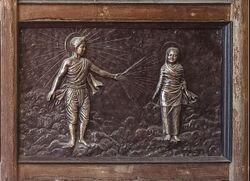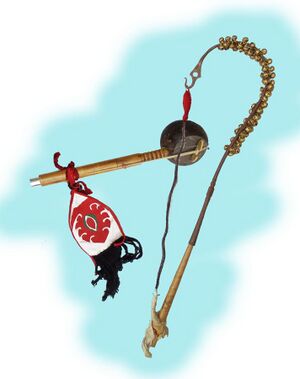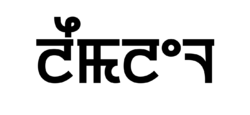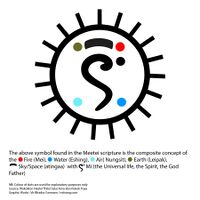Religion:Leimarel Sidabi
| Leimarel Sidabi (Old Manipuri: Leimalel Sitapi) | |
|---|---|
Goddess of earth, nature and household | |
| Member of Imung Lais | |
 A relief depicting the creation of goddess Leimalen (Leimalel) by Salailen (Salailel), the Supreme God | |
| Other names |
|
| Ancient Meitei | |
| Affiliation | Meitei mythology (Manipuri mythology) and Meitei religion (Sanamahism) |
| Abode | Sanamahi Kachin (Lainingthou Kachin)[1] |
| Artifacts | Water pot (Isaiphu or Esaiphu)[2] |
| Animals | Taoroinai |
| Symbol | Water pot (Isaiphu or Esaiphu)[2] |
| Texts | Wakoklon Heelel Thilel Salai Amailon Pukok Puya, Leithak Leikharol, Leisemlon, Sakok Lamlen and many others |
| Gender | Female |
| Region | Ancient Kangleipak (early Manipur) |
| Ethnic group | Meitei ethnicity |
| Festivals | Lai Haraoba |
| Personal information | |
| Consort | Salailen (Soraren) |
| Children | Sanamahi (foster) and Pakhangba (biological) |
| Greek equivalent | Gaia |
| Roman equivalent | Terra |
Leimarel Sidabi (Meitei: ꯂꯩꯃꯔꯦꯜ ꯁꯤꯗꯕꯤ) or Leimalel Sitapi (Meitei: ꯂꯩꯃꯂꯦꯜ ꯁꯤꯇꯄꯤ) is a goddess in Meitei mythology and the religion of Ancient Kangleipak (early Manipur). She is the highest female divinity in the Meitei pantheon. She is the goddess of earth, of nature and the household. She is revered as the mother of every living being in the universe.[2][3][4][5]
Presently, the market complex number 1 is named after her at the Ima Keithel (Mothers' market), the world's only market run exclusively by women.[6][7][dubious ]
Etymology
The Meitei word "Leimarel" (ꯂꯩꯃꯔꯦꯜ) or "Leimaren" (ꯂꯩꯃꯔꯦꯟ) means "queen" or "goddess" in English. The word "Leimarel" (or "Leimaren") can be broken into the syllables "Lei" (ꯂꯩ), "Ma" (ꯃ) and "-ren" (-ꯔꯦꯟ) or "-rel" (-ꯔꯦꯜ). "Lei" means land or earth. "Ma" means mother. "-ren" (or "-rel") means excellent. The Meitei word "Sidabi" can be broken into "Si" (ꯁꯤ), "-da" (ꯗ) and "-bi" (-ꯕꯤ). "Si" ("See") means "to die". "-da" denotes negative meaning. "-bi" ("-bee") denotes feminine gender.[8][9]
Description
Leimarel is the eternal mother goddess. In ancient times, the ruling royal couples sat in the Laplen Ka (the central room). They faced the sacred spot of goddess Leimarel. It was believed that men and women originated from Leimarel's womb. A house symbolises the Mother in traditional Meitei cosmic beliefs.[10]
Mythology
The supreme creator Atingkok (alias Salailel) asked his two sons, Sanamahi and Pakhangba to run in a race around the world. The winner would become the ruler of the world. Sanamahi was stronger than his younger brother, Pakhangba. He started his journey. Pakhangba wept to his mother, Leimarel Sidabi. She told him the secret behind the throne of the universe. The secret is that going around the throne of the Supreme Being is equivalent to going around the universe. So, Pakhangba went around the Supreme Being, his father. Thus, he won the race and became the ruler of the universe. When Sanamahi returned home, he found his younger brother sitting on the throne. He got angry. He attacked Pakhangba. Pakhangba ran away. He hid himself among seven lairembis (celestial divine maidens).[11][12] The Supreme Being intervened the situation. He brought peace of Sanamahi. He made Sanamahi as the king of the household of the mankind. At the same time, goddess Leimarel Sidabi became another Imung Lai (household deity), besides Sanamahi.[2][11]
According to some legends, goddess Ima Leimaren (lit. Mother Leimarel) takes care of the market. She brings peace and harmony by doing so. This tradition is still maintained by womenfolk. The women are considered as the descendants of the "Ima".[13]
During the infant world, the creator God Atingkok Maru Sidaba asked goddess Leimarel Sidabi to produce another goddess from herself. After the production, the new goddess was named as Emoinu (Imoinu), who was sent to earth as the guardian goddess of humankind.[14]
Texts
Several ancient texts (PuYas) write things about the goddess Leimarel (Old Manipuri: Leimalen). Some include the Leimaren Naoyom (Old Manipuri: Leimalen Naoyom), the Leimaren Langon (Old Manipuri: Leimalen Lang-ngon), the Leimaren Mingkhei (Old Manipuri: Leimalen Mingkhei), the Leimaren Shekning Lasat (Old Manipuri: Leimalen Shekning Laasat), the Leimaren Ungoiron (Old Manipuri: Leimalen Ungkoilon), besides other texts.[15]
Worship
Leimarel Sidabi and her son Sanamahi are worshipped in the first room of every Meitei household. Goddess Leimarel doesn't want the Korou Anganba (English: sunlight) in the morning. So, houses of Loi castes are mainly made facing southwards. She lives in water also. So, she is worshipped in an Isaiphu (an earthen pitcher or terracotta pot containing water).[2] There are no images kept to represent the two deities inside their abode.[16]
A senior woman of a house fills the earthen pot of the goddess with fresh water. She does this after taking a holy bath. Fresh flowers, fruits, vegetables and rice are offered. Prayers are also offered to protect the family members from every troubles.[17][18]
The maibas perform rites and rituals by chanting hymns dedicated to goddess Leimaren (ancestral mother goddess). It is generally done inside the house. Water, rice and flowers are mainly placed.[19]
Shayon (incarnations)
Leimarel Sidabi is known for her various incarnation in different forms possessing diverse attributes.
The following are her incarnations:
| Divine forms | Description |
|---|---|
| Chang Ning Leima | She is the goddess and consort of Lord Khoriphaba, the prince of sky kingdom. |
| Emoinu | She is the goddess of wealth, prosperity and happiness. |
| Ereima | She is the goddess of water and bodies of water. |
| Hikubi Yaikubi | She is the goddess of gems and wealth. |
| Ngaleima | She is the goddess of fish and aquatic life. |
| Nongthang Leima | She is the goddess of thunder and rain. |
| Panthoibi | She is the goddess of courage, war and nostalgia. |
| Phouoibi | She is the goddess of paddy, prosperity and harvest. |
| Pithai Khongdaibi | She is the mother goddess of all. |
| Silleima | She is the goddess of work and occupations. |
| Thumleima | She is the goddess of salt and nutrients. |
Festivals
Goddess Leimarel Sidabi and her son Sanamahi are mainly worshipped in many religious occasions. Some are Sajibu Cheiraoba and Saroi-Khangba. Cheiraoba is the Meitei new year (Manipuri new year) festival. Saroi-Khangba is a religious event to please the evil spirits.[20][21][22][23]
- In the festival of Mera Chaorel Houba, God Lainingthou Sanamahi and goddess Leimarel Sidabi are worshipped in the famous Sanamahi Temple by offering fruits and vegetables.[24]
- In the Meitei festival of Sajibu Cheiraoba, goddess Leimarel Sidabi is worshipped by offering her the uncooked rice by the devotees.[25]
Pantheon
Goddess Leimarel Sidabi, besides being worshipped in Manipur, Assam and Tripura, has her pantheon in Bangladesh and Myanmar too. In Myanmar, one of the famous shrines of Ema Leimarel Sidabi is located at the Ye Ki Bauk village, where the Meitei people worship her.[26][27]
In Arts

Among the nine forms of musical rhythms (Seisaks) of Pena (musical instrument), the Leimarel Sheisak is one. This singing style (tune) of Meitei tradition (Manipuri culture) is sung during the festival of Lai Haraoba.[28][29]
In the novel The Tales of Kanglei Throne, goddess Leimarel Sidabi is presented as Nongda Nongkhal Lembi.
Namesakes
In commerce
Ima Keithel (English: Mothers' Market) is the world's only women run market. It has 3 major complexes.[30][31][32] Leimarel Sidabi Ima Keithel is the Complex Number 1 of the market. It is followed by Imoinu Ima Keithel (Complex Number 2) and Phouoibi Ima Keithel (Complex Number 3).[33] This 500 year old market is in the center of Imphal, Manipur.[32]
In geography
The Leimarel Hill is a hill in Manipur. Trekkers go here for panaromic viewing of 360 degree of Loktak Lake.[34]
References
- ↑ Gitam, Kanishq (2022-01-12) (in en). Asatoma Sadgamaya A path for one. Blue Rose Publishers. pp. 207. https://books.google.com/books?id=V7NYEAAAQBAJ&q=corner+of+the+room+I+was+in+was+called+Sanamahi+Kachin%2C+which+was+dedicated+to+Leimarel+Sidabi+and+Phungga%2C+deities+of+Sanamahism&pg=PA207.
- ↑ Jump up to: 2.0 2.1 2.2 2.3 2.4 Devi, Lairenlakpam Bino (2002) (in en). The Lois of Manipur: Andro, Khurkhul, Phayeng and Sekmai. Mittal Publications. pp. 48. ISBN 978-81-7099-849-5. https://books.google.com/books?id=tIBymmBWqgsC&dq=leimaren+sidabi&pg=PA48.
- ↑ Meitei, Sanjenbam Yaiphaba; Chaudhuri, Sarit K.; Arunkumar, M. C. (2020-11-25) (in en). The Cultural Heritage of Manipur. Routledge. pp. 221. ISBN 978-1-000-29637-2. https://books.google.com/books?id=c276DwAAQBAJ&q=Leimarel+is+the+universal+mother&pg=PT221.
- ↑ Karna, Mahendra Narain (1998) (in en). Social Movements in North-East India. Indus Publishing. pp. 200. ISBN 978-81-7387-083-5. https://books.google.com/books?id=-3FJEfU3swcC&q=Leimarel+Universal+Mother+&pg=PA200.
- ↑ Devi, Dr Yumlembam Gopi (16 June 2019) (in en). Glimpses of Manipuri Culture. Lulu.com. pp. 23. ISBN 978-0-359-72919-7. https://books.google.com/books?id=gxqeDwAAQBAJ&dq=leimaren&pg=PA23.
- ↑ "Trade resumption at Khwairamband unlikely right after May 3 Ima Market No 1 to be fitted with CCTV cameras". https://www.thesangaiexpress.com/Encyc/2020/4/28/By-Our-Staff-ReporterIMPHAL-Apr-27-To-check-dirtying-and-other-unsanitary-activities-inside-Ima-Keithel-No-1-Ima-Leimarel-Sidabi-Keithel-CCTV-cameras-would-be-fitted-inside-the-market-complex-.html.
- ↑ "April 27, 2020 – Manipur News". 27 April 2020. http://www.manipur.org/news/2020/04/27/.
- ↑ "Learners' Manipuri-English dictionary_Leimaren". 2006. https://dsal.uchicago.edu/cgi-bin/app/sharma_query.py?qs=%EA%AF%82%EA%AF%A9%EA%AF%83%EA%AF%94%EA%AF%A6%EA%AF%9F&searchhws=yes.
- ↑ "Learners' Manipuri-English dictionary_Leimaren Sidabi". 2006. https://dsal.uchicago.edu/cgi-bin/app/sharma_query.py?qs=%EA%AF%82%EA%AF%A9%EA%AF%83%EA%AF%94%EA%AF%A6%EA%AF%9F%20%EA%AF%81%EA%AF%A4%EA%AF%97%EA%AF%95%EA%AF%A4&searchhws=yes.
- ↑ Muthukumaraswamy, M. D.; Kaushal, Molly (2004) (in en). Folklore, Public Sphere, and Civil Society. NFSC www.indianfolklore.org. pp. 70. ISBN 978-81-901481-4-6. https://books.google.com/books?id=Xsrgg1Mel8UC&q=++laplen+ka+central+room+faced+spot+Leimarel+eternal+Mother+whose+womb+men+women+originate+Meitei+cosmic+belief+represents+Mother+&pg=PA70.
- ↑ Jump up to: 11.0 11.1 A Critical Study Of The Religious Philosophy. August 1991. pp. 71. https://archive.org/details/in.ernet.dli.2015.461915/page/n71/mode/2up?q=Leimarel+Leimalel.
- ↑ Devi, Lairenlakpam Bino (2002) (in en). The Lois of Manipur: Andro, Khurkhul, Phayeng and Sekmai. Mittal Publications. pp. 47. ISBN 978-81-7099-849-5. https://books.google.com/books?id=tIBymmBWqgsC&dq=leimaren+sidabi&pg=PA47.
- ↑ Kipgen, Tingneichong G. (2010) (in en). Women's Role in the 20th Century Manipur: A Historical Study. Gyan Publishing House. pp. 32. ISBN 978-81-7835-803-1. https://books.google.com/books?id=sIEOy8SRLv8C&q=According+to+legends+%E2%80%9C+Ima+Leimaren+%E2%80%9D+took+charge+of+the+market+to+bring+peace+and+harmony+.+Women+maintain+the+tradition+as+they+are+considered+the+descendents+of+%27+Ima&pg=PA32.
- ↑ "Emoinu". http://e-pao.net/epSubPageExtractor.asp?src=reviews.books.emoinu.
- ↑ Meitei, Sanjenbam Yaiphaba; Chaudhuri, Sarit K.; Arunkumar, M. C. (2020-11-25) (in en). The Cultural Heritage of Manipur. Routledge. pp. 137. ISBN 978-1-000-29637-2. https://books.google.com/books?id=c276DwAAQBAJ&q=Leimaren+Naoyom%2C+Leimaren+Langon%2C+Leimaren+Mingkhei%2C+Leimaren+Shekning+Lasat%2C+Leimaren+Ungoiron+and+many+others.+There+are+also+other+books+on+many+subjects.+&pg=PT137.
- ↑ Bareh, Hamlet (2001) (in en). Encyclopaedia of North-East India. Mittal Publications. pp. 247. ISBN 978-81-7099-790-0. https://books.google.com/books?id=XScmdGvMf7IC&dq=leimaren&pg=PA247.
- ↑ Devi, Dr Yumlembam Gopi (in en). Glimpses of Manipuri Culture. Lulu.com. pp. 16. ISBN 978-0-359-72919-7. https://books.google.com/books?id=gxqeDwAAQBAJ&dq=leimaren&pg=PA16.
- ↑ Devi, Dr Yumlembam Gopi (in en). Glimpses of Manipuri Culture. Lulu.com. pp. 32. ISBN 978-0-359-72919-7. https://books.google.com/books?id=gxqeDwAAQBAJ&dq=leimaren&pg=PA32.
- ↑ Meitei, Sanjenbam Yaiphaba; Chaudhuri, Sarit K.; Arunkumar, M. C. (2020-11-25) (in en). The Cultural Heritage of Manipur. Routledge. pp. 288. ISBN 978-1-000-29637-2. https://books.google.com/books?id=c276DwAAQBAJ&q=+maiba+comes+performs+rites+rituals+chanting+hymns+shrine+ema+leimaren+sidabi+ancestral+mother+goddess+water+rice+flowers&pg=PT288.
- ↑ Devi, Lairenlakpam Bino (2002) (in en). The Lois of Manipur: Andro, Khurkhul, Phayeng and Sekmai. Mittal Publications. pp. 49. ISBN 978-81-7099-849-5. https://books.google.com/books?id=tIBymmBWqgsC&dq=leimaren+sidabi&pg=PA49.
- ↑ Devi, Dr Yumlembam Gopi (in en). Glimpses of Manipuri Culture. Lulu.com. pp. 68. ISBN 978-0-359-72919-7. https://books.google.com/books?id=gxqeDwAAQBAJ&dq=leimaren&pg=PA68.
- ↑ Bareh, Hamlet (2001) (in en). Encyclopaedia of North-East India. Mittal Publications. pp. 183. ISBN 978-81-7099-790-0. https://books.google.com/books?id=XScmdGvMf7IC&dq=leimaren&pg=PA183.
- ↑ A Critical Study Of The Religious Philosophy. August 1991. pp. 117. https://archive.org/details/in.ernet.dli.2015.461915/page/n117/mode/2up?q=Leimarel+Leimalel.
- ↑ "People celebrates Mera Chaoren Houba". Pothashang. 21 September 2017. http://www.pothashang.in/2017/09/21/people-celebrates-mera-chaoren-houba/.
- ↑ "Wakching Nongma Panba Cheiraoba : Offering uncooked food items to Ema Leimarel Sidabi at Awang Sekmai :: 10 January 2016 ~ Pictures from Manipur". http://www.e-pao.net/epGallery.asp?id=4&src=Festival/Cheiraoba/WakchingCheiraoba20160110.
- ↑ "Myanmar Meetei mou at Ema Leimarel Sidabi temple at Ye Ki Bauk village Myanmar 20170220". http://e-pao.net/epSubPageExtractor.asp?src=news_section.Press_Release.Press_Release_2017.Myanmar_Meetei_mou_at_Ema_Leimarel_Sidabi_temple_at_Ye_Ki_Bauk_village_Myanmar_20170220.
- ↑ "'Ema Leimarel Sidabi' at 'ye ki bauk' earlier known as Meetei khul, Amarapur District, Myanmar :: December 2016 ~ Pictures from Manipur". http://www.e-pao.net/epGallery.asp?id=32&src=News_Related/Archived_News_Photo/NewsPhotoArchive_2017_1.
- ↑ Meitei, Mayanglambam Mangangsana (2021-06-06) (in en). The Sound of Pena in Manipur. Marjing Mayanglambam. pp. 34. ISBN 978-93-5473-655-1. https://books.google.com/books?id=j7E2EAAAQBAJ&dq=leimarel&pg=PA34.
- ↑ Khiangte, Zothanchhingi (2016-10-28) (in en). Orality: the Quest for Meanings. Partridge Publishing. pp. 169. ISBN 978-1-4828-8671-9. https://books.google.com/books?id=3rJ3DQAAQBAJ&dq=leimarel&pg=PT169.
- ↑ Gupta, Om (2006) (in en). Encyclopaedia of India, Pakistan and Bangladesh. Gyan Publishing House. ISBN 978-81-8205-389-2. https://books.google.com/books?id=eENU_a8c79MC&q=ima+keithel+market+khwairamband+only+women+world&pg=PA974.
- ↑ Shivhare, Vishal (2016-08-17) (in en). Vyapar Shastra. Jaico Publishing House. ISBN 978-81-8495-898-0. https://books.google.com/books?id=vjzcDAAAQBAJ&q=ima+market+nupi+keithel+only+women+world&pg=PT37.
- ↑ Jump up to: 32.0 32.1 Singh, Dr Th Suresh (2014-06-02) (in en). The Endless Kabaw Valley: British Created Visious Cycle of Manipur, Burma and India. Quills Ink Publishing. ISBN 978-93-84318-00-0. https://books.google.com/books?id=kbu_AwAAQBAJ&q=ima+keithel+market+only+women+world&pg=PA4.
- ↑ "All-women Imphal market reopens after 10 months". The Times of India. 16 February 2021. https://m.timesofindia.com/city/imphal/all-women-imphal-market-reopens-after-10-months/amp_articleshow/80974793.cms.
- ↑ Singh, Arambam Sanatomba (2021-06-18) (in en). Ecotourism Development Ventures in Manipur: Green Skill Development and Livelihood Mission. Walnut Publication. pp. 87. ISBN 978-93-91145-59-0. https://books.google.com/books?id=7YQ8EAAAQBAJ&q=trekking+in+the+evening+to+nearby+Leimarel+Hilltop+and+Chaoba+Ching+for+panaromic+viewing+of+360+degree+of+Loktak+Lake&pg=PA87.
Bibliography
- Ariba Meiteigee Seitha by Gourachandra, Mayanglambam
- Kangleikhol January 1988 by Kangjia, Ng
- Leimarel Mingkhei by Bhogeshawr, Oinam
- Yimpallon by Singh, Wakhemcha Tomba
External links
| Wikimedia Commons has media related to Leimarel Sidabi. |
- Internet Archive, Leimarel
- E-pao, Leimarel
- Journal on Sanamahism religion (read 5th paragraph )
- celebrates-mera-chaoren-houba/ Celebrating Sanamahism festival
- NATURE WORSHIP
 |



